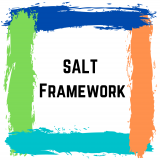The SALT Framework
A Process Framework to Guide Risk Communication
As the U.S. Environmental Protection Agency pursues its mission to protect human health and the environment, EPA staff practice risk communication every day. Effectively communicating science and potential health risk is one of the most important jobs we have. The SALT Framework is based on a process of Strategy, Action, and Learning and is supported by Tools that together provide a research-based approach and best practices for communicating our work to the American people.
What is risk communication?
Risk communication is communication intended to provide a general or specific audience with the information they need to make informed, independent judgments about risks to their health, safety and the environment. Risk communication should be meaningful, understandable, and actionable. Risk communication works best when it is a two-way process where the Agency listens to, learns from, and meets the needs of specific audiences. In practice, this is not always possible in the short term or in all situations, but improving our understanding of the needs of our audiences and responding to those needs should remain an ongoing EPA goal.
What is the difference between risk communication and crisis communication?
EPA often needs to communicate about risk during an immediate threat to human health or the environment during a crisis situation that we were unable to, or did not appropriately, plan for. Crisis communication is a subset of risk communication in response to an event or a crisis. All the elements of risk communication apply in crisis communication, but urgency is paramount, and audience stress is typically elevated.
Who is the SALT Framework for?

This framework is for anyone who communicates risk on behalf of EPA. Due to the nature of EPA’s mission to protect human health and the environment, communicating risk is inherent to any mission-relevant work at the Agency. Risk communicators at EPA include a wide spectrum of employees, including staff working on policy, in public affairs, and as scientists, in addition to those working directly on community outreach and engagement, and in emergencyoperations.
Strategy
Moving Away from the Deficit Model
Many people start risk communication with the view that if they can just give their audience the facts, it will change their beliefs, attitudes and behaviors related to a given risk and EPA’s work to address it (this is known as the knowledge deficit model of communication). Decades of research from the psychological and decision, risk, and management sciences has shown that this is not true. People make decisions for many complex reasons, and not all of them have to do with what a scientist or EPA official might see as a numerical, factual risk. The good news is that there is also much research that points the way to what does work. One of the first steps to moving beyond the deficit model is to broaden goals and objectives that go beyond providing information strategically.
Strategic risk communication should include: taking stock and leveraging existing sources of knowledge; setting big picture goals and corresponding objectives; and matching platforms and tactics to those goals and objectives. This process should also focus on how success will be measured and how the project will be refined as needed to achieve it. The strategic planning step can end with a simple list or a more formal risk communication plan that includes many parts and roles. The important thing is to use this planning process to design risk communication activities to achieve EPA’s goals and objectives.

Strategy Steps and Definitions
- Take Stock: Leverage knowledge inside the Agency and with partners before undertakinga risk communication project.
Example: Seek out information from colleagues in the Region, from the EJ office, and from other offices that have a history in the community, the contaminant, or other relevant issues. - Establish Goals: Goals are the big picture of what you hope to accomplish with a risk communication effort. Goals will be connected to the Agency mission to protect human health and the environment.
Example: Decrease a specific risk taking behavior in an audience. - Set Objectives: Objectives are measurable interim steps clearly linked to achieving the goal. Objectives typically involve beliefs and feelings held by an audience and/or increasing their knowledge.
Example: Increase self-reported trust in EPA as a messenger on issues of health in the community. - Choose Platforms: Platforms are sometimes called vehicles or channels. They are the way the message will reach your audience.
Example: Website content, social media content or public meeting. - Match Tactics: Tactics are techniques used to build or convey content. Some tactics are shown to be more effective than others at reaching specific audiences or achieving specific objectives.
Example: Narrative storytelling vs. standard Q and A, accessible interactive meeting design vs. public forum style.
Action
Considering Risk Communication Factors to Help Ensure a Positive Outcome
When it comes to taking action and implementing the plan developed in the strategy step, it is important to consider a variety of factors that can affect the success of a given risk communication. Research shows that these risk communication factors have a clear impact on whether an audience can hear, understand, accept and act on a specific message. While some of these factors cannot change, taking them into account and using appropriate tactics can improve outcomes. A few examples of these factors are listed below, but this list is not exhaustive. Considering these factors can help the communicator take steps to improve the chances that an activity will achieve strategic risk communication goals and objectives.
Risk Communication Factors
A wide variety of factors can impact if an audience can hear, understand, accept and act on a given risk communication message. While some of these factors cannot themselves be changed, taking them into account and using appropriate tactics can improve outcomes.
Hazard Factors

There are certain factors inherent in a given hazard that can affect how an audience feels about the risk. Many of these factors are defined as issues of “risk perception” in the research. Risk perception issues are issues of perspective. They are valid ways for an audience to assess risks, but they may not strictly align with the data. For example, people generally are more concerned with risks that are seen as uncontrolled or related to children.
Helpful tactics: 1) to put the risk into context and 2) to provide meaningful and achievable action steps that can help reduce stress and make risk-reducing behavior change more possible.
Relationship Factors

These are variables that are based on the relationship between the communicator and the audience. Trust is one example. Trust underlies an audience’s ability to hear a message and willingness to act on it. Trust can be hard to build, especially if it has eroded over time.
Helpful tactic: Establishing shared values early in a communication is one tactic to build trust.
Audience Factors

These are variables that are related to the audience. Some examples include language, literacy, numeracy, identity, cultural norms and biases, community history, time and economic stressors.
Helpful tactic: One example of a tactic that can help with all audiences but especially those with low numeracy is to include visual representations of risk.
Communication Factors

These are variables that are connected directly to the communicator. Several examples include identity, competence and expertise, stress level, and comfort with engagement.
Helpful tactics: Tactics that can help include mock presentations, selecting communicators who share identity characteristics with the audience, or matching the right communicator to the task.
EPA and Science Factors

These are factors that connect directly either to EPA’s role or to the science that drives our decision making. Sometimes, the regulations governing a specific contaminant affect the messaging about it. As one example, during risk reviews of the regulations governing air toxics, EPA determines an “acceptable cancer risk” expressed as the number of cancer cases per million people resulting from a lifetime exposure. At other times, uncertainty in data must be addressed, such as in the results of a monitoring study. These are inherently complicated concepts to explain, and, in many communities, no cancer risk is going to be considered “acceptable.”
Helpful tactics: 1) to show empathy for the very real concerns of the audience regardless of whether those concerns are seen as falling under EPA’s regulatory mandate, and 2) be transparent about what we know and what we don’t know.
Coordinating with Partners to Make Messages More Meaningful
Sometimes a community partner can be a far better communicator of EPA risk communication messages than EPA staff. There are times when issuing communications jointly with other trustworthy sources (for example, credible university scientists, physicians, or trusted local officials) can lead to a more positive outcome than EPA communicating alone. It is important to take time to coordinate communications both within EPA and across organizations in order to make messaging from all partners more meaningful, understandable and actionable. With credible and authoritative intermediaries, determine who is best able to answer questions about risk. Audiences typically do not distinguish between different governmental partners. Coordinating in advance can improve perceptions of trust in all partners.
Learning
An integral component of implementing the risk communication plan is using a process to evaluate and learn from risk communication efforts across the EPA. Evaluating risk communication efforts by soliciting feedback from audiences and colleagues can produce valuable insights to inform future efforts. Through using a reflective practice model (see box on the right), communicators can identify new knowledge and lessons learned that will help them continually improve their risk communication practice.
How to Incorporate Reflective Practice into your Risk Communications
A reflective practice approach identifies lessons learned but goes further by specifying how this learning will inform future individual or group efforts. It also helps risk communicators apply the strategy in this framework to a variety of situations by encouraging learning from past outcomes. Following the steps of reflective practice have been shown to improve future outcomes.
The practice can be implemented both internally on the individual or team level and with external audiences. By using guided discussion, a short survey, or focus groups, reflective practice can easily become a routine part of risk communication. It will help identify how audiences are responding to risk messages and point to key adjustments that will help ensure improvement over time. Whether the process is formal or informal, it is important to document results, so they are available to inform future efforts.
Examples of Reflective Practice: After-action assessment, such as a debrief, “hot wash,” or other type of assessment is a key part of a reflective practice approach. When using this approach, it is important to incorporate questions about your expectations and the reasons for them in your strategy (the first step in the SALT framework), so you can assess whether you met those expectations afterwards.
Example: “I expect the stakeholders will have a lot of questions about this message, because it is significantly different than our original communication with them. I expect there will be gaps in their understanding, and they will want an explanation to help them understand what has changed.”
When you engage in a debrief, hot wash, or focus group to assess the experience against your strategy’s expectations, identify insights and surprises, and consider changes you might make in your approach.
Example: “Stakeholders were more interested in our current assessment than in how it has changed from the past, so I overestimated the level of detailed explanation they would want about that. Next time I might want to assess that at the beginning of the meeting, so I don’t provide unnecessary information.”
The cycle of reflective practice continues when the insights gathered are applied to the next risk communication effort to inform expectations and approaches.
Tools
We are always adding to our list of tools, which include contaminant specific toolkits, case studies, practical tools and templates, and more. Visit the Risk Communication Tools and Resources webpage for more information.
